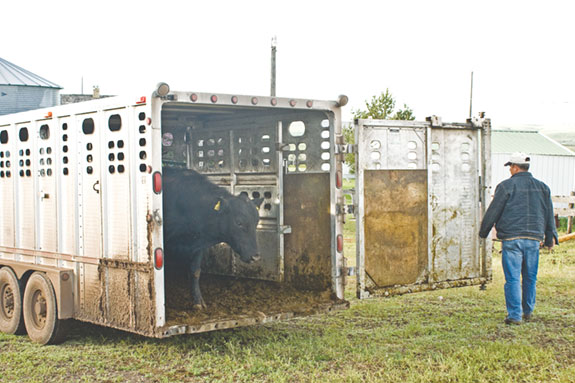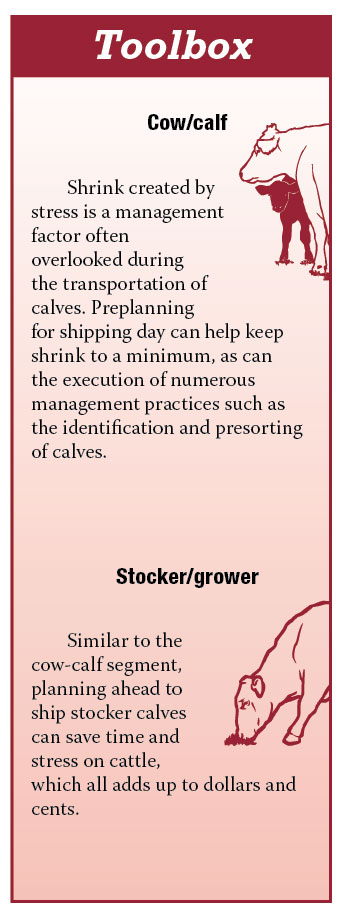Shrink isn’t strictly a transportation issue, but often an overlooked management factor that occurs during the transport and marketing of cattle. Fill shrink is the loss of rumen fill, manure and urine; it can be recovered in a short period of time. Tissue shrink is a decrease in the weight of the carcass and other body tissues. It is generally associated with long periods without feed and water, for example long hauls.
If you don’t manage for shrink, it can cost you money. Here are some tips for how you can keep those dollars in your pocket, while keeping animal and human stress to a minimum.
Prepare to ship
The biggest key to minimizing shrink is being prepared. But first, you need to stop and give some thought to your whole marketing process, advises Willard Wolf of Crossroads Cattle Co. in Spokane, Washington.
Wolf, who has sorted and loaded a good many cattle in his profession, encourages people to prepare their cattle for shipping day, starting when the calf is young.
Identify
“If you’re going to sell cattle, start around the time the calf is born,” he said. Tag the steer and heifer calves with different colored ear tags. The reason: “Anytime you want to sort thereafter, it’s done really fast and very efficiently.” Wolf said this causes less shrink and stress on cattle. And stress plays a major role in animal health.
Presort ahead
Wolf’s best advice is to presort cattle at least seven days prior to shipment. Sorting them one day before isn’t long enough – it adds additional shrink and more stress to shipping day.
Sorting cattle seven days prior, gives them time to settle back down. Therefore, sort the steers from the heifers, cut out your replacement heifers and sort off the outliers – the calves that don’t fit the weights and kinds being sold.
Better yet, Wolf highly encourages presorting and grouping cattle by weight on pasture. He says this can make a big difference in minimizing prehandling shrink and help marketing efforts.
For example, if cattle are pastured according to weight, you won’t have to sort through 400 head to find 150 six-weight steers to ship when the market is favorable for this weight.
If you’re going to sell cattle through auction barns, Wolf advises you presort these cattle seven days ahead too. If you have one load, load steers in the front, heifers in back and keep outliers separate. Then, be sure they’re unloaded accordingly. This way, cattle are presexed, presorted and ready to run into the sale ring without additional sorting and added stress at the auction yard.
He strongly encourages producers to give thought to the gathering and sorting process when selling cattle at auction; otherwise, they can incur horrendous shrink. Especially if cattle are sorted off from a large group the first day, then trucked the second day to the auction barn where, upon arrival, they still need to be sorted.
Also, pick an auction barn for the manner in which personnel handle your cattle, especially if you’re selling newly weaned calves. Find out when your calves sell and time your arrival as such. Don’t ship and unload calves at 6 a.m. if they won’t sell until 6 p.m.

Plan ahead for trucking
Line up a responsible livestock transporter ahead of time. Word-of-mouth and experience are often your best bets. Other considerations are on-time deliveries, as well as communication.
Wolf advises producers call the trucking firm and give them the details: how many cattle you have to ship from what state, how many pounds, and the destination. He says, let the trucking firm figure the mileage because they know what states to go across.
For shorter hauls, especially to auction barns, know what you’re going to ship, and then order trucks accordingly. This way, there’s enough trailer space to fit cattle comfortably. Tighter cattle mean more shrink.
Prepare paperwork early
Health certificates and, in Western states, brand papers, are needed for interstate shipment. Therefore, have this paperwork in order early and before cattle are loaded. The brand inspector won’t inspect cattle once they’re on the truck.
Wolf’s rule of thumb is this: “We double-check with the brand inspector and the veterinarian, if he’s coming on-site. We contact them three to four days before shipment date and double-check with them the evening before shipment and confirm the time.”
Certify, double-check scales
If you’re weighing on-site, double-check that your scale is certified and in proper working condition. If you’re weighing on-truck, Wolf said it’s very important to check with the company whose scales you’ll be using, even if you’ve used them successfully in the past. Do this before shipping day to avoid further delays. Also, weigh as close to your ranch as possible.
Clear the roadway
“If there are any road restrictions or major construction in the direction you’re going to weigh cattle on-truck, make sure the roadways are clear and restrictions are off,” Wolf said. “You don’t want any delays, because you’re going to take additional shrink.” In the event of unclear roadways, be sure truck drivers are directed on alternate routes.
Choose your crew
Choose your help wisely. Don’t pick help because they’re fun, entertaining or bring the cooler of best beverages. Instead, pick the calm, capable person. Communicate with them on shipping day; three minutes of your time can save both you and your cattle extra stress.
“If you’ve got some help coming that day, brief them on how your corrals and scales work,” Wolf advises. “Assign them a job and tell them exactly what they’re supposed to do, but don’t wait until you start weighing cattle.” And leave dogs home that day.
Watch the weather
Weather is another stress and shrink factor. Although you can’t predict it, you can watch and choose your time to ship. “Weather is a very important part of selling your cattle,” Wolf points out. And it affects your selling price.
For example, if it’s sunny in Spokane, Washington, but storming in the Midwest, it’s going to affect your price that week. Midwest buyers aren’t going to ship cattle across those weather conditions – trucks could get hung up in a road closure, cattle may sit on a truck, and get tremendously stressed and shrunk.

Prepare facilities
Make sure your facilities are in working order. Some facilities may be used only a few times per year, but their upkeep is still very important. Proper design of these corrals and portable panels and loading chutes need to work with the flow of cattle. Curve facilities and watch blind corners; also accommodate rear-loading trucks.
Know how many head your facilities are capable of holding. In short: have cattle you can handle and facilities to handle the cattle. More nervous-type cattle tend to shrink even more.
Feed for shipment
It’s very crucial that you don’t feed your cattle fresh green alfalfa hay the night before shipment. The reason: once you start working and weighing, everything turns green. Wolf explains, the cattle come off grass, their diet is changed and they take additional shrink.
Dry grass hay is best, he says. If the calves are already off grass, this isn’t as important. His rule of thumb here: nothing rich and green if cattle are coming from a dry situation.
Load and get down the road
If possible, pick a more moderate temperature day or, at least, choose the time of day you load out. Heat is worse than cold; it causes cattle to get run out and shrink even more.
Cattle aren’t normal freight. When they’re transported, the goal is to minimize their time on the truck. That’s why you want it to get down the road as soon as it’s loaded, especially if you’re shipping off-weight–meaning the seller is paid on the cattle’s destination weight off the truck. An extra 15 to 20 minutes here and there can really add up. ![]()
Kim Holt, Progressive Cattleman contributor
TOP PHOTO: Photo courtesy of Kim Holt.
BOTTOM PHOTO: For shorter hauls, especially to auction barns, know what you’re going to ship, and then order trucks accordingly. Photo by Progressive Cattleman staff.







